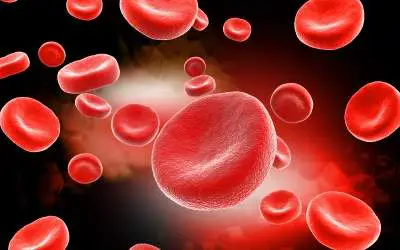Red blood cells are major cells of liquid connective tissue blood. The blood is red in color due to the abundance of these cells in it.
However, unlike other body cells, they lack the essential cell organelles including the nucleus.
Hence, these are also called as blood corpuscles.
Red blood cells Structure

The blood corpuscles as shown in pic are biconcave shaped discs. They have a mean diameter of 7.8 micrometers.
And by thickness, they have a width of 2.5 micrometers at the thickest point and 1 micrometer or less in the center.
Their volume is 90 to 95 cubic micrometers. They float freely in the blood due to their shape and low weight.
They are also termed as erythrocytes and are abbreviated as RBC’s. They are formed in the red bone marrow of long bones by erythropoesis.
Their life span is 120 days. Due to continuous flow inside the blood vessels, they get worn out. Their membranes become fragile and break down in the endothelial reticulum of the spleen. Latter, they are completely removed from the blood by the liver.
In the liver, the hemoglobin is metabolized into bile pigments viz. bile-Rubin and Bili-verdin and the iron (heme). This heme is resued in the body.
Red blood cell count
The concentration of red blood cells per cubic millimeter is 5,200,000 in men and is 4,700,000 in women.
Their decline is seen during pregnancy, severe menstruation disorders in women, and in all due severe disease conditions. A decrease in red cell count or abnormality in their shape results in anemia.
Source of red blood cells
They are formed in the red bone marrow of long bones.
They internally have a pigment called hemoglobin. This hemoglobin is made of heme (iron) and protein globulin part.
They combine to form a proteinaceous substance in complex with iron molecules. This pigment helps to carry oxygen by these cells.
RBC function
Their main function is to transport of gases like oxygen and carbon dioxide.
1. Transport of oxygen: They transport oxygen from the lungs of the respiratory system to all the tissues and cells in the body. They do it by a reversible combination of oxygen with hemoglobin within them. When the RBC’s flow through the alveoli of the lungs, the oxygen exchanges between alveolar tissue and hemoglobin until hemoglobin gets saturated. At the point of saturation, in a healthy individual, 1 gram of hemoglobin holds 1.39ml of oxygen.

For determining the oxygen level in blood see to this page describing the amount of oxygen in the blood.
Oxygen is present in dissolved form and also inbound form to hemoglobin.
2. Transport of carbon dioxide: They help in the transport of carbon dioxide from tissues to the lungs. They contain carbonic anhydrase enzyme that catalyzes the reversible reaction between carbon dioxide (CO2) and water to form carbonic acid (H2CO3), thereby increases the rate of the reaction. Thus formed carbonic acid is transported by water in the blood.
Also, some amount of carbon dioxide can bind to hemoglobin directly.
3. pH Maintenance: The pH of blood is 7.3 and it is always kept constant by homeostasis. The presence of hemoglobin acts as an acid-base buffer, thus the red blood cells beside other factors are responsible for the acid-base buffering power of whole blood.
Frequently asked questions and answers
Where are red blood cells made in our body?
Red bone marrow of large bones is the organ where the red blood cells are made in the body.
What destroys red blood cells?
Reticulo endothelial system in spleen and liver destroys worn out red blood cells.
Thank you . The information was so helpful !
Its best post .
thank you